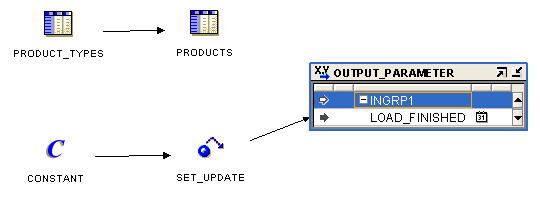
Owb Target Filter For Update Oracle
Feb 25, 2012 - Oracle Warehouse Builder Data Modeling, ETL, and Data Quality Guide. Example: Updating a Target Schema. Target Filter for Update. What is Oracle Warehouse Builder? An all in one solution to build, deploy, and run Data Warehouse ETL (Extract, Transform, Load) code. Used for bulk updates. Target schema usually exists in a separate database but can be in the same database. OWB Key Features.
In 11.2 releases, Change Data Capture (CDC) can be done by code template mapping. This allows users to capture the data changes from heterogeneous data source, and load into the target across different platforms. Here is an example that captures the data change in DB2 table DB2_DEPT, and then loads it into Oracle table DEPT. It would have expected that the deletion change can also be captured when the data source is from heterogeneous platform, then all insert/update/delete changes can be done in one simple mapping. However, due to some issue, the deletion change may not work as expected. And this example provides a solution to the CDC from DB2 table to Oracle table.
Assuming the table DB2 table DB2_DEPT is as follows: The primary key of DB2_DEPT is column DEPTNO. And the given Oracle table DEPT looks like below, whose primary key is column DEPT. And now, let’s set up code template mappings to load the CDC from DB2_DEPT to Oracle table DEPT. Create source and target modules respectively, and import source and target tables into OWB. After importing the table DEPT, let’s copy the table DEPT and paste it under the same Oracle module, and then rename it to DEPT$. This is to create a DEPT-like table DEPT$, which will be used to save the temporary deletion records from the source.
Set up the CDC for source table. To capture the data change in DB2 database, we can use the built-in code template JCT_DB2_UDB_SIMPLE. And this can be configured from the DB2 module editor as follows: First, select the table that will be captured. In this example, I choose the table DB2_DEPT, and shuttle it from the left to the right side. And then, specify the code template JCT_DB2_UDB_SIMPLE to capture the change.
Start the CDC and subscribe the changes from the source table. We can start the CDC by right-clicking the DB2 module. When it’s done, we can begin to subscribe the changes from table DB2_DEPT. It will ask for the subscriber name before subscribing, and you can input any name as you like. I input the subscribe name as “SUNOPSIS” here.
Import the Journal table from source database Now, we need to import the journal table. The journal table contains the changes for the source table, and is created automatically when starting the change data capture. By default, the journal table’s name begins with J$_, and then follows with the source table name. Thus, the journal table is J$_DB2_DEPT in this case.
Let’s get table J$_DB2_DEPT into OWB now. Create a procedure in the target module to clean up the temporary table DEPT$. We also need to create a procedure to clean up the deletion records in the temporary table DEPT$ after CDC loading is executed. It can be created as simple as this: 6. Create code template mappings to load changed data There are 3 mappings required to perform the loading of all kind of data changes. A) Mapping to load deletion records to Oracle temporary table DEPT$. Note that the filter condition above must look like: INOUTGRP1.JRN_FLAG = 'D' And INOUTGRP1.JRN_SUBSCRIBER = 'SUNOPSIS' This is to only select the deletion records with the subscribe name we defined previously.
• No sales or soliciting donations. Lianja app builder serial mom. • Posting NSFW content is not allowed. • Do not discuss cheats. • Use spoiler tags when appropriate. • No witch hunting.